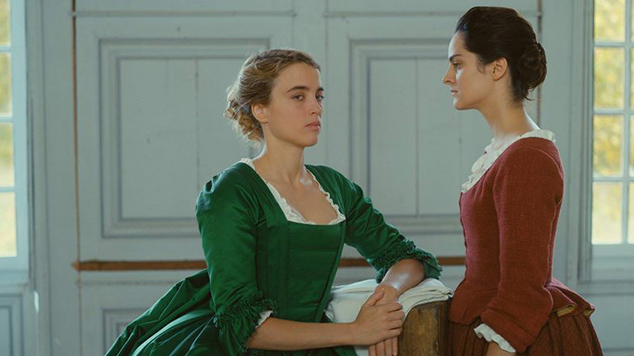
Portrait of a Lady on Fire | Perth Festival | ★ ★ ★ ★ ½
French screenwriter and director Céline Sciama’s body of work focuses on people as they become aware of their sexuality, those moments when sexuality and identity are formed and break free. Her previous work as a director includes the film Waterlilies, Tomboy and Girlhood, a trilogy of films about women as they come of age. She also wrote the screenplay to André Téchiné’s 2016 film Being 17, which focuses on two young men exploring their sexuality.
With her fourth film, Portrait of a Lady on Fire, Sciama stays in familiar thematic territory but takes on the challenges of filming a period drama.
At the end of the 18th century Marianne (Noémie Merlant) is a painter working from one commission to the next. While male painters can easily command large figures for a commission, women in the industry find it more difficult to make a living. As she explains at one point, women are considered not to be qualified enough to paint men, as they are banned from study the nude male form in their training. Instead they must make do with what work is left over, and are almost always painting other women.
She is hired to paint a portrait of a young women, Héloïse (Adèle Haenel), whose lives with her mother on a remote island in Brittany. Following the death of her older sister, Héloïse has been betrothed to marry her dead siblings finance who lives in Milan. The wedding will only go ahead if he likes the look of his replacement bride, hence the sudden need for a portrait to be painted.
Marianne arrives at the remote estate, which is on an island where no men live, and is greeted by the lone servant Sophie (Luàna Bajrami). The next day she meets Héloïse’s aristocratic mother The Countess (Valeria Golino) who explains that she is not the first painter to be brought in to create a portrait of her daughter. As Héloïse had a falling out with the previous artist and destroyed their portrait, Marianne is asked to paint her subject in secret, posing just as a woman to the house as a companion for the lonely young woman.
She must study Héloïse closely, and commit to memory every detail of her face, and then secretly paint her late portrait at night after she has retired for the evening.
When the Countess is called away to the mainland, the three young women are left alone in the house. Quickly the conventions of mistresses and servants are abandoned and the three women treat each other as equals and begin to gain a greater understanding of the restrictions each of them face in their lives because of their gender. Slowly a relationship develops between Héloïse and Marianne, one that they know has no long term viability.
Sciama has created an incredibly beautiful film, it’s filmed with allegories to painting, each table setting looking like a still life, scenes with women’s hair blowing in the wild sea wind like they are characters out of classic myths and fables. Filled with lingering close ups, it encourages us to gaze upon the faces of these women, as we would a portrait hanging in a gallery The story moves slowly, almost like we’re waiting for the paint to dry, but it builds slowly layering observations about the women’s limited choices and lack of power in the world.
It’s a film filled with symbolism, the island is surrounded by wild seas making it difficult to reach or escape, just as the women are unable to break free from their destinies and expectations. Flowers bloom and wilt as the women embrace the rush of their sexual awakening, only to have to deal with the unavoidable return to society’s conventions.
The film won the Queer Palm at the Cannes Film Festival and was also awarded Best Screenplay, and it’s been talked up as a possible Oscar contender in 2020. It’s a powerful, heartbreaking and beautiful film that slowly works it way up to it’s climatic finale.
Graeme Watson






